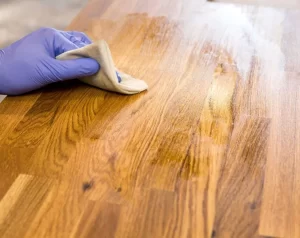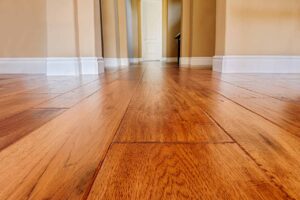Did you know that the type of flooring we choose for our homes can greatly impact the overall aesthetic and functionality? Well, it’s true!
In fact, according to recent statistics, one particular type of flooring stands out as the most common choice among homeowners.
In this article, we will explore the various popular options available and delve into their advantages and disadvantages. Additionally, we will discuss important factors to consider when selecting flooring materials and provide tips on how to make the best decision for your space.
So let’s get started!
Key Takeaways What Is the Most Common Type of Flooring
- Hardwood flooring is the most common type of flooring in modern homes.
- Laminate flooring is also a popular choice among homeowners.
- Vinyl flooring is another common option for many households.
- Bamboo flooring is gaining popularity due to its eco-friendly properties.
5 Popular Types of Flooring
The most common type of flooring in modern homes is hardwood, followed closely by laminate and vinyl. Hardwood flooring is a popular choice due to its timeless appeal and durability. It adds warmth and elegance to any space, making it a favored option among homeowners. However, hardwood can be expensive, especially for high-quality materials like oak or maple.

On the other hand, laminate flooring offers cost-effective options that mimic the look of real wood at a fraction of the price. It is also easy to install and maintain. Vinyl flooring, another cost-effective option, comes in various styles and designs, including those that resemble hardwood or stone. Additionally, both laminate and vinyl are eco-friendly choices as they often use recycled materials.
Moving on from these cost-effective and eco-friendly choices, let’s explore the advantages and disadvantages of these common flooring options.
Advantages and Disadvantages of Common Flooring Options
When it comes to flooring options, you’ll want to consider the advantages and disadvantages of each. To help you make an informed decision, we have compiled a table below that outlines the benefits and drawbacks of some common flooring materials.

| Flooring Option | Advantages | Disadvantages |
|---|---|---|
| Hardwood | – Adds value to your home – Durable and long-lasting – Classic and timeless look |
– Expensive upfront cost – Susceptible to scratching and water damage – Requires regular maintenance |
| Laminate | – Affordable option – Easy installation – Wide variety of designs available |
– Not as durable as hardwood – Can be slippery when wet – Difficult to repair if damaged |
| Vinyl | – Cost-effective choice – Water-resistant and easy to clean – Soft underfoot for added comfort |
– Prone to fading with prolonged exposure to sunlight – Limited design options compared to other materials |
When considering your flooring options, it’s important not only to think about the cost-effectiveness but also the eco-friendliness. For those looking for more environmentally friendly choices, materials like bamboo or cork can be great alternatives. These renewable resources are sustainable and offer unique aesthetics. Additionally, they are naturally resistant to moisture, making them ideal for areas prone to water exposure.
Overall, there are various factors to weigh when choosing the right flooring for your space. By considering both cost-effective options and eco-friendly choices, you can find a flooring material that meets your needs while also aligning with your values.
Factors to Consider When Choosing Flooring for Your Home
To choose the right flooring for your home, you should consider various factors.
One important factor to consider is cost-effectiveness. There are several options available that can fit within a budget while still providing quality flooring. Laminate flooring, for example, offers a cost-effective option that mimics the look of hardwood or tile at a fraction of the price.

Another factor to consider is eco-friendliness. Many homeowners today are opting for sustainable and environmentally friendly flooring materials. Bamboo flooring is a popular choice as it is renewable and grows quickly, making it an eco-friendly alternative to traditional hardwood floors. Cork flooring is also a great option as it comes from the bark of cork oak trees which regenerate every few years.
The Pros and Cons of Different Flooring Materials
If you’re considering different flooring materials, it’s important to weigh the pros and cons of each option. Here are some factors to consider:
- Environmental impact: Some flooring materials, such as hardwood or bamboo, are sustainable and renewable resources. Others, like vinyl or carpet, may have a higher environmental impact due to their production process or use of chemicals.
- Maintenance requirements: Different types of flooring require varying levels of maintenance. Hardwood floors need regular cleaning and occasional refinishing, while tiles may require grout cleaning and sealing. On the other hand, carpets may need more frequent vacuuming and professional cleaning.
- Durability: The durability of flooring materials can vary greatly. Hardwood floors are known for their longevity, while laminate or vinyl options may be more prone to scratches or wear over time.
- Cost: Flooring costs can vary significantly depending on the material chosen. Hardwood tends to be more expensive upfront but can add value to your home in the long run.
Considering these factors will help you make an informed decision about which flooring material is best suited for your needs and preferences.
How to Select the Right Flooring for Your Space
Consider the size and function of the space as you evaluate which flooring material will best suit your needs. Flooring is an important aspect of any space, as it not only adds to the overall aesthetic but also affects its functionality. To help you make an informed decision, we have compiled a table showcasing different flooring materials along with their pros and cons.
| Flooring Material | Pros | Cons |
|---|---|---|
| Hardwood | Durable, timeless look | Expensive, requires regular maintenance |
| Laminate | Affordable, easy to install | Not as durable or authentic-looking as hardwood |
| Vinyl | Waterproof, low maintenance | Susceptible to scratches and dents |
When selecting flooring for your unique space, be sure to consider these factors: durability, cost, ease of installation and maintenance. Additionally, here are some general flooring maintenance tips:
- Regularly sweep or vacuum to remove dirt and debris.
- Wipe up spills promptly to prevent staining.
- Use rugs or mats in high-traffic areas to protect the floor.
With these ideas in mind, you can choose the perfect flooring that complements your space while being practical and visually appealing.
Frequently Asked Questions
How Much Does It Cost to Install Carpet Flooring?
When it comes to installing carpet flooring, the cost can vary depending on factors such as the size of the area and the type of carpet chosen. However, compared to other types of flooring, carpeting generally offers benefits like comfort and insulation.
Can Laminate Flooring Be Installed in Bathrooms?
Laminate flooring in bathrooms has both pros and cons. It’s affordable and easy to clean, but moisture can cause damage. To maintain it in wet areas, avoid excessive water exposure and promptly clean up spills.
Are There Any Eco-Friendly Flooring Options Available?
There are several eco-friendly flooring options available today, including bamboo flooring. Bamboo is a sustainable material that grows quickly and requires minimal pesticides or fertilizers. It also has a beautiful appearance and is highly durable.
What Is the Average Lifespan of Hardwood Flooring?
The average lifespan of hardwood flooring can vary, but it typically lasts for decades with proper care. Engineered wood flooring is a great alternative, offering similar benefits at a lower cost.
Can Vinyl Flooring Be Installed Over Existing Tiles?
Yes, vinyl flooring can be installed over existing tiles. It offers several benefits such as durability, moisture resistance, and easy maintenance. However, it’s important to consider the pros and cons before making a decision.
Conclusion
In conclusion, when it comes to choosing the most common type of flooring for your home, there are several options to consider. Each type has its own advantages and disadvantages, so it’s important to weigh them carefully.
From hardwood and laminate to carpet and tile, the choices can be overwhelming. However, with proper research and consideration of factors like durability, maintenance, and cost, you can find the perfect flooring that suits your needs.
Remember, just like in life, finding the right flooring is all about balance – balancing style with functionality and comfort with practicality. So go ahead, take a step towards creating a space that truly reflects who you are!




